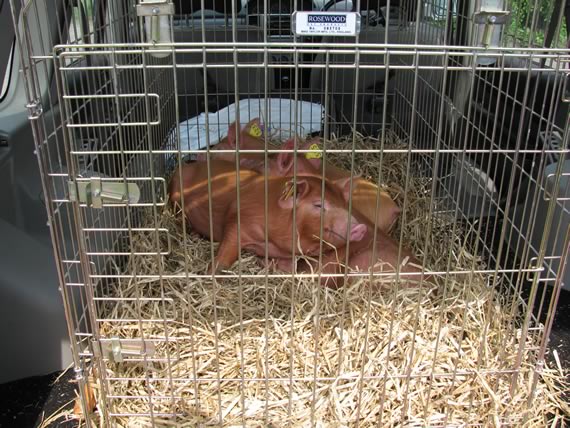Transporting, moving and handling pigs
Once you've bought your pigs you'll need to get them home. Although young pigs are small, bear in mind that they can be strong, boisterous, produce extremely smelly dung and don't have any obvious "handles". They also make an incredible amount of noise - an ear-splitting shriek - when being handled. Fortunately, they turn it off as soon as you put them down.
Try not to handle them within earshot of the sow, which might just spring to their defence. The easiest way to move young pigs is simply to pick them up by the back legs, with their back against you, and carry them. Even at eight weeks, weaners are heavy so try and get the trailer as close as possible.
Ideally, a trailer is best but whatever you use, it must be able to be properly cleaned and disinfected and should have a non-slip floor, so that the piglets don’t hurt themselves. For a few weaners, a large trailer is too big and they may hurt themselves, so use hurdles to keep them in an enclosed area.
 We sometimes transport weaners in a puppy cage in the back of the car
We sometimes transport weaners in a puppy cage in the back of the car
When you get the piglets home, keep them in a small area overnight to let them settle down. The following day you can start getting them used to you – patience and apple slices (see Health and Wellbeing page) are required.
We brought home our first piglets in the newspaper-lined back of our old Citroen car (with the windows wide open!). Now that we are better educated, we use a large puppy crate, lined with straw and placed in the back of the car (windows still wide open, though). In our experience the pigs will sleep most of the way. Also plan exactly what you're going to do when you get them home - the less stress for you and the pigs in getting them into their home the better.
Getting pigs to the abattoir
Keep in mind the issue of transport at the other end of the enterprise – while a couple of weaners are just fine in a puppy cage, it won’t do for a couple of porkers. If you can, it’s a good idea to get your pigs used to loading prior to the day you are taking them to the abattoir.
From Day 1, call them to be fed and get them used to the sound of food rattling in a bucket. A few days before you need to load them, feed them in the trailer or at least on the ramp, then in the trailer the next day. If you can do this, it will make the real thing much less stressful for you and the pigs.
Adult pigs are usually moved using a board to guide them and a stick to tap them with to keep them moving. If you are building a race to move them along, make sure it has solid sides and is fixed at ground level – if a pig can see through it, it will try to push through and remember a pig uses its snout a lot, so it’s very powerful – easily able to lift a poorly fixed hurdle or barrier.
Pig movement licences
If you are moving pigs between holdings (including the abattoir), you will need to complete a Pig Movement Licence (AML2). If you are taking animals to market or to slaughter, you will also have to complete a Food Chain Information (FCI) form; this is a declaration to say that the animals are fit for human consumption. Some markets and abattoirs have their own combined forms, often available to download from their website.
Standstill periods
Once you bring your pigs home, your holding will be under a standstill i.e. for a period no stock can legally be moved off the holding. This is a disease control measure and the length of the standstill is related to the incubation period for Foot and Mouth Disease in the particular species. These are the standstill periods that apply in Scotland.
- Bringing pigs on to your holding triggers a 20 day standstill on other pigs.
- Bringing pigs on to your holding triggers a 13 day standstill on cattle, sheep and goats.
- Bringing cattle, sheep and goats on to your holding triggers a 20 day standstill on pigs.
- Bringing cattle, sheep and goats on to your holding triggers a 13 day standstill on other cattle, sheep and goats.
A number of exemptions are permitted to the standstill rules. These include the movement of animals going direct to a slaughterhouse; the movement of breeding animals; young lambs going for fostering; and young calves moving for fostering or to calf rearing premises.
Other exemptions are in place for show/exhibition animals; and for movements where animals are held in authorised separation facilities. Your Animal Health office will be able to provide details.
- Previous « Buying Pigs
- Next Pig Housing »

About Rosemary Champion
Rosemary lives on a 12 acre smallholding in Angus, in the east of Scotland, where she keeps Ryeland Sheep, Shetland cattle and assorted poultry. She was destined to be a smallholder from an early age.
Further Reading
 Pigs: A Guide to Management Neville Beynon |  Pig Keeping (Countryside Series) Richard Lutwyche |  Small-Scale Outdoor Pig Breeding Wendy Scudamore |  Pig Ailments: Recognition and Treatment Mark White |  Know Your Pigs Jack Byard |
Smallholding shop
When you click links below and make a purchase, this may result in this site earning a commission from eBay.

Pig Board 94 x 76
94cm x 76cm small Pig board. … from £31.20 + p&p

Pig Board Large 120 x 76
120cm x 76cm Large Pig board. … from £40.56 + p&p

Long Handled Pig Catcher
Long Handled Pig Catcher.Heavy… from £14.72 + p&p


















